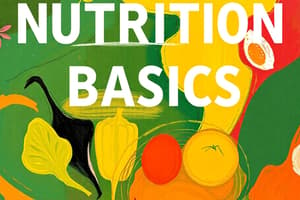Podcast
Questions and Answers
What is classified as obesity in adults based on BMI?
What is classified as obesity in adults based on BMI?
- BMI of 30 or more (correct)
- BMI of 20 or less
- BMI of 35 or more
- BMI of 25 or more
Diet-related noncommunicable diseases include respiratory illnesses.
Diet-related noncommunicable diseases include respiratory illnesses.
False (B)
What term describes an imbalance between energy consumed and energy expended?
What term describes an imbalance between energy consumed and energy expended?
obesity
Micronutrient deficiencies, such as _____ and vitamin A, pose major health threats.
Micronutrient deficiencies, such as _____ and vitamin A, pose major health threats.
Match the following dietary standards with their descriptions:
Match the following dietary standards with their descriptions:
Which of the following is a top risk factor for diet-related noncommunicable diseases?
Which of the following is a top risk factor for diet-related noncommunicable diseases?
The term 'imbalance nutrition' refers solely to a deficiency of nutrients.
The term 'imbalance nutrition' refers solely to a deficiency of nutrients.
What defines overweight in adults based on BMI?
What defines overweight in adults based on BMI?
What does REI/RNI stand for?
What does REI/RNI stand for?
Food quality only refers to the sensory attributes of a food item.
Food quality only refers to the sensory attributes of a food item.
What is a primary consideration when assessing food quality?
What is a primary consideration when assessing food quality?
Food quality is defined as the degree of _____ and the fitness for _____ of food.
Food quality is defined as the degree of _____ and the fitness for _____ of food.
Match the following food quality characteristics with their descriptions:
Match the following food quality characteristics with their descriptions:
Which of the following is NOT a factor that affects food choices?
Which of the following is NOT a factor that affects food choices?
Individual level factors have no significant impact on food choices.
Individual level factors have no significant impact on food choices.
Name one macro-level environmental factor that influences food choices.
Name one macro-level environmental factor that influences food choices.
What is the primary component of an enzyme system?
What is the primary component of an enzyme system?
Malnutrition refers only to deficiencies of nutrients.
Malnutrition refers only to deficiencies of nutrients.
What suffix is commonly used to identify enzymes?
What suffix is commonly used to identify enzymes?
The condition resulting from a lack of essential nutrients is called __________.
The condition resulting from a lack of essential nutrients is called __________.
Match the forms of malnutrition with their definitions:
Match the forms of malnutrition with their definitions:
Which of the following is NOT a sub-form of undernutrition?
Which of the following is NOT a sub-form of undernutrition?
A child who is underweight may also be stunted.
A child who is underweight may also be stunted.
What is defined as having a high supply of nutrients resulting in harmful effects?
What is defined as having a high supply of nutrients resulting in harmful effects?
What is the primary purpose of nutrients in the body?
What is the primary purpose of nutrients in the body?
All food substances are inorganic.
All food substances are inorganic.
Define nutrition.
Define nutrition.
Nutrients that provide energy are known as __________.
Nutrients that provide energy are known as __________.
Which of the following is a function of enzymes?
Which of the following is a function of enzymes?
Match the types of nutrients with their primary functions:
Match the types of nutrients with their primary functions:
Nutritional education does not impact a person's nutritional status.
Nutritional education does not impact a person's nutritional status.
What can influence food choices?
What can influence food choices?
Flashcards are hidden until you start studying
Study Notes
Introduction to Nutrition
- Nutrition is the study of food, nutrients, and their chemical constituents and how they impact health.
- Effective nutrition education enhances the state of nutritional well-being throughout life.
Definitions
- Nutrition: Combination of processes through which organisms receive and utilize materials for growth and maintenance.
- Food: Any organic or inorganic substance that nourishes the body when ingested.
- Nutrient: A chemical component necessary for energy provision, tissue repair, and regulation of life processes.
Nutrients
- Functions of Nutrients:
- Provide energy for biochemical reactions.
- Build and repair body tissues.
- Regulate various bodily functions to maintain homeostasis.
- Types of Nutrients:
- "Go Foods": Provide energy.
- "Grow Foods": Build the body.
- "Glow Foods": Regulate body processes.
Nutritional Status
- Defined as the condition of the body from utilizing essential nutrients.
- Classification:
- Good Nutrition: Adequate supply and utilization of nutrients.
- Malnutrition: Results from a lack of essential nutrients (deficiency) or excessive nutrient supply (over-nutrition).
- Forms of Malnutrition:
- Undernutrition: Inadequate intake leading to issues like wasting, stunting, and underweight.
- Overnutrition: Imbalance between energy intake and expenditure, often resulting in overweight or obesity.
Overnutrition and its Implications
- Overweight and obesity classified by Body Mass Index (BMI):
- Overweight: BMI of 25 or more.
- Obesity: BMI of 30 or more.
- Linked to diet-related noncommunicable diseases, such as cardiovascular diseases and diabetes.
Micronutrient Related Malnutrition
- Results from inadequacies in vitamins and minerals necessary for proper growth and development.
- Essential micronutrients include iodine, vitamin A, and iron, with deficiencies posing a significant health threat, particularly in low-income countries.
Imbalance Nutrition
- Describes a pathological state due to disproportional nutrient intake, affecting metabolic health.
Dietary Standards
- Set minimum nutrient requirements tailored by age, sex, weight, and health conditions, known as Recommended Energy Intake (REI) or Nutrient Intake (RNI).
Food Quality
- Defined as the degree of a food product's excellence and its fitness for human consumption.
- Quality factors include identity, net quantity, sensory attributes, stability, wholesomeness, and proper packaging and labeling.
Factors Affecting Food Choices
- Environmental Factors:
- Macro-level influences from society.
- Physical environments where food is procured and consumed.
- Social interactions and norms surrounding food.
- Individual Level Factors: Personal preferences, health conditions, and socio-economic status influencing food selection.
Studying That Suits You
Use AI to generate personalized quizzes and flashcards to suit your learning preferences.




